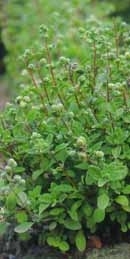Gardens Ablaze
Marjoram
It's better to remain
silent and be thought a fool than to open your mouth and remove all doubt.
- Mark Twain
Additional Marjoram Information
Medicinal Uses
Recipes
Magic & Superstition
Site Map
Home
Annuals
Architectural Elements
Backyard
Habitat
Biennials
Bonsai
Bulbs
Cactus/Xeriscaping
Companions
Composting
Container
Gardening
Crafts
Gardening Q/A
Garden Ornamentation
Gargoyles
Greenhouses
Ground Covers
Herbs
Houseplants
Insects/Diseases
Landscaping
Organics
Perennials
Ponds
Propagation
Recipes
Roses
Seeds
Shade Gardens
Shrubs/Hedges
Tools
Trees
Vegetables
Vines
Weeds
Wildflowers
Wildlife
Shop Gardening
 Marjoram
is a tender perennial
that is usually grown as an annual. It grows to 2 feet high at most, and
is a welcome addition to front or mid border positions in the herb garden. Its
has stems with many branches filled with oval gray-green leaves that cascade
down to make a nice mound. As the stems touch the ground, they root,
making the mound gradually bigger. This growth habit makes Marjoram an excellent choice for containers, as it cascades
gracefully down the side of the pot.
Marjoram
is a tender perennial
that is usually grown as an annual. It grows to 2 feet high at most, and
is a welcome addition to front or mid border positions in the herb garden. Its
has stems with many branches filled with oval gray-green leaves that cascade
down to make a nice mound. As the stems touch the ground, they root,
making the mound gradually bigger. This growth habit makes Marjoram an excellent choice for containers, as it cascades
gracefully down the side of the pot.
Marjoram is an
excellent culinary herb that blends well with other seasonings. It is
often used in turkey stuffings, and is a subtly perfumed, calming herb.
The leaves can be used dried or fresh. Its taste is reminiscent of mild oregano, and it can be used as an oregano substitute. It
retains much of
its flavor when dried, but should be kept away from bright sunlight to preserve
the color and taste.
Marjoram seeds are very small and are usually started indoors and transplanted
outside after all danger of frost has passed. The seedlings are small, so
be sure that weeds do not overtake them before they are established. Stem
cuttings are an easier way to propagate this plant, as they root readily and are
true to the parent plant. Marjoram prefers rather rich, well-drained soil
in full sun or dappled shade. As always, mulch is a good idea to minimize
weeds. Marjoram makes a good companion plant for other
herbs and vegetables. See Companion
Planting for more details.
Use Marjoram in a variety of dishes, including beef, veal, lamb, poultry, vegetables and potatoes. It can also be used in herbed butters and flavored oils and vinegars.
![]() Custom Search
Custom Search
Gardens Ablaze